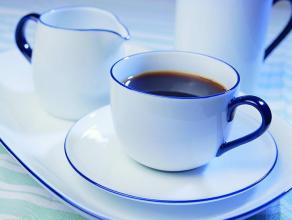Introduction to the description of the characteristics and flavor of Panamanian jadeite manor coffee varieties with Qingyang fruit flavor
The story starts from the last century and from the digging of the Panama Canal. This maritime traffic route, on a par with the Suez Canal, and the geographical dividing line between North and South America, should also be the first landmark that comes to mind when the world talks about Panama.
The construction of the Panama Canal lasted 30 years from 1883 to 1914. The project was initially led by the French, and then the development rights fell to the Americans, during which as many as 50,000 craftsmen and technicians were employed, many of whom were engineers from northern Europe. Toleff Bache M ö nniche is one of them.
The Norwegian engineer, who graduated from Dresden College in Germany, was in charge of gate technology at the port of Cologne on the Panama Canal. Tropical rain forest climate in Panama, hot and humid and mosquito ravages make it difficult for many Nordic people to adapt, continue to suffer from disease, many people died as a result. In 1911, Toleff Bache, who had suffered from malaria for the fourth time, took a steamboat along the Pacific coast to Bopquete, a small town in Chiriqui province, where the dry climate and fresh air allowed him to recover. Deeply in love with the land, he returned here in 1924 with his wife Julia and bought a piece of land at the foot of the Baru volcano, what is now Lilida Manor. They built their own house here, Nordic-style architecture, and have lived here ever since, and started three ways of running the coffee plantation, namely, the sun plantation, the full shade plantation and the semi-shade plantation. Plantations with more than 50 plants per hectare are fully shaded plantations, 25-50 plants are semi-shaded plantations, and less than 25 plants are called sunshine plantations. What is the effect of shading and shading on coffee in the plantations of the two neighbors with the same planting conditions? Shading plantations can slow down the ripening time of coffee fruits, so there are more flavor substances in coffee cherries, so shading itself increases the cost and reduces production, and its coffee flavor is higher than that of semi-shaded plantations under the same planting conditions. now most plantations in Colombia are associated with coffee trees and bananas because Arabica trees are becoming more and more dwarfed. Therefore, when the banana tree rises, it plays a shading role in the Pokuit producing area, where there are many excellent manors, except the famous Emerald Manor, Alida Manor, Aqaba Manor and so on. All produce high-quality boutique coffee. This is not only due to the superior ecological conditions of the Pokuit region of Panama and the fertile volcanic ash soil of the Baru volcanic land. Another important factor is that the microclimate in the Poquet Heights of Panama is a unique and important resource for boutique coffee in the Pokuit region. This is the Panamanian environment from east to west that allows cold air to converge above 6500 feet through the Central Mountains, thus creating a variety of microclimates in the Pokuit region, making its temperature and rainfall very suitable for plant growth. so the coffee trees grown here grow very well.
In Poquet's unique planting environment, there is naturally not only the rose summer of emerald, the king of coffee, regardless of flavor, quality and value, but I think it is quite extravagant to drink rose summer every day, and even if there is no economic pressure, it is not like eating shark's fin and bear's paw every day. The same is true of coffee. Only by dabbling in a wide range of subjects can you enjoy the pleasure of tasting coffee more.

Important Notice :
前街咖啡 FrontStreet Coffee has moved to new addredd:
FrontStreet Coffee Address: 315,Donghua East Road,GuangZhou
Tel:020 38364473
- Prev

An introduction to the description of the characteristics and Flavor of Coffee varieties in Incht Manor, Guatemala, with balanced acidity
Guatemala is bordered by Mexico to the north, Honduras and El Salvador to the south, the Caribbean to the east and the Pacific Ocean to the west, with tropical rain forests, volcanic geology, plateau valleys and changeable microclimate. Guatemalan coffee once enjoyed a reputation as the best quality coffee in the world. The extra-hard coffee beans here are full-grained, delicious and balanced, and the coffee made with it is pure and strong.
- Next

Introduction to the flavor description of moderate and mellow coffee varieties in Santa Cruz, Ecuador
When Thomas and the crew landed on the island, they were frantically looking for water and were so thirsty that they squeezed juice from the fat leaves of the cactus to drink. At last a source of water was found in a rocky gully. Thomas attributed it to the gift of God, because it was good Friday, and they had piously celebrated mass before they set out in search of water. But Thomas will never
Related
- Does Rose Summer choose Blue, Green or Red? Detailed explanation of Rose Summer Coffee plots and Classification in Panamanian Jade Manor
- What is the difference between the origin, producing area, processing plant, cooperative and manor of coffee beans?
- How fine does the espresso powder fit? how to grind the espresso?
- Sca coffee roasting degree color card coffee roasting degree 8 roasting color values what do you mean?
- The practice of lattes: how to make lattes at home
- Introduction to Indonesian Fine Coffee beans-- Java Coffee producing area of Indonesian Arabica Coffee
- How much will the flavor of light and medium roasted rose summer be expressed? What baking level is rose summer suitable for?
- Introduction to the characteristics of washing, sun-drying or wet-planing coffee commonly used in Mantenin, Indonesia
- Price characteristics of Arabica Coffee Bean Starbucks introduction to Manning Coffee Bean Taste producing area Variety Manor
- What is the authentic Yega flavor? What are the flavor characteristics of the really excellent Yejasuffi coffee beans?

